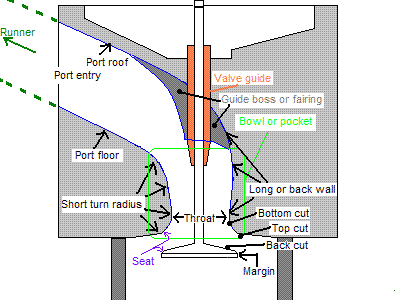Texas4x4hoe
Member
- Joined
- Dec 16, 2010
- Messages
- 47
Thanks for all the input guys. As far as the case lengths all my cases were all 2.010" or less. As soon as it quits raining I'm going to test some 308 win brass.
OK, now I'm with you.
Industry standards says that leade section in the picture can also be called the throat. The freebore part in the picture is just that; not part of the throat at all. 'Tis another issue of different names used for the same things across us folks.
FREE BORE
A cylindrical length of bore in a firearm just forward of the chamber in which rifling is not present. Associated with bullet jump.
LEADE (LEAD)
That section of the bore of a rifled gun barrel located immediately ahead of the chamber in which the rifling is conically removed to provide clearance for the seated bullet. Also called Throat or Ball Seat.
THROAT
See Leade (Lead).
Except throats in virtually all things having them are constantly tapered; bigger at one end than the other.Throat seems to be more intuitive to me as a description of the overall area between the case neck and full height lands.
Yes I FL resize and trim the cases.35.0 grains of Varget is a tick below minimum even if the MKE brass has the NATO cross. If it doesn't, it's not NATO spec brass and you're way below minimum.
2.820" is too long too. Load to a max OAL of 2.810", no ogives involved. It's from the pointy part to the flat part. Forget the off-the-lands stuff until you have worked up a load.
You check the case lengths and FL resize?
I also weighed a CBC case vs the Hornady case and the CBC was right at 10 grains heavier with both being sized and trimmed the same.
The one left I had loaded in the NATO brass was 0.336" and the three Hornady cases I just loaded are all 0.335". Working my way up with the hornady cases now with no issues so far. 37.1gr went 2140 and ejected nicely.The 10 grs heavier would seem to be the problem.
Check loaded round neck diameter of both. If larger then .344" may produce excess pressure.
Except throats in virtually all things having them are constantly tapered; bigger at one end than the other.
I admit I'm a "stick in the mud" by preferring to use industry standards instead of what personally seems correct. That simplifies interpretation by the receiver when the transmitter communicates something.


OK, but I've no memory for the term "throat" to include the freebore constant diameter area between chamber mouth and leade until you did it earlier in this thread.when I talk with others about the features of a rifle chamber I'll use the commonly accepted terminology,
OK, now I'm with you.
Industry standards says that leade section in the picture can also be called the throat. The freebore part in the picture is just that; not part of the throat at all. 'Tis another issue of different names used for the same things across us folks.
